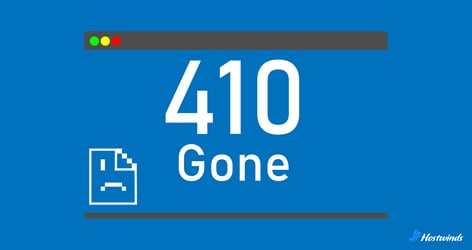Hostwinds Blog
Search results for:

410 Status Code - When and How to Use it
by: Hostwinds Team / September 5, 2024
HTTP status codes are short messages sent by a server to inform your browser about the success or failure of its request. Among these, the 4xx series deals with client errors, and within this series, the 410 status code is specific to managing web content.
What is the 410 Status Code?
The 410 status code—or "410 Gone"—means that the requested resource has been permanently removed from the web server. Unlike the 404 status code (which indicates that a page might return), the 410 status code is a clear signal to both web browsers and search engines that the page is gone for good.
When to Use a 410 Status Code
One of the most important things to understand about the 410 status code is that it tells search engines to stop crawling and indexing a page. Therefore, it should only be used if you are certain that a page is no longer relevant or doesn't present any value to your website.
Common Reasons to Use 410 Status Code
- Expired Promotions: Pages set up for limited-time offers or one-time events.
- Irrelevant Content: Information that is no longer relevant or accurate, such blog posts that don't align with your website or old news articles.
- Discontinued Products: Product pages for items no longer sold or supported on your site.
- Rapid De-indexing: Search engines will remove the page from their index more quickly compared to a 404.
- Clean Architecture: Helps maintain a well-organized site, which can positively impact overall SEO.
When Not to Use 410 Status Code
While the 410 status code is useful, there are several situations where using other status codes would be more appropriate.
- Maintenance/Updates: If your site or a page is temporarily down for maintenance or content update, using a 410 status code would send the wrong signal. Instead, use a 503 Service Unavailable or 302 redirect to indicate the temporary nature of the issue.
- Outdated Content: Pages with outdated content, like an old blog post, may still carry SEO value. Instead of removing it, consider updating the content or 301 redirect it to a page of contextually relevant content.
- Seasonal Content: Pages that are relevant at certain times of the year, such as holiday promotions, shouldn't be marked with a 410. Instead, consider a 302 redirect during off-season periods.
- High-Traffic Pages: If a page has valuable backlinks, instead of using a 410 status, implement a 301 redirect to a related, live page. This will push the SEO value of the backlinks to the new page.
410 Status Code vs. 404 Status Code
While both the 410 and 404 status codes indicate that a page is unavailable, they serve different purposes. The 404 status code suggests that the page might be temporarily unavailable, possibly due to a broken link or a typo in the URL. Search engines will continue to crawl these pages thinking they will return.
On the other hand, the 410 status code tells search engines and users that the page is permanently gone and not coming back. This distinction is very important for SEO, as using the wrong status code can lead to inefficient crawling and potential drops in search rankings.
Using the right code ensures that search engines handle your site correctly—404s might still be checked by crawlers, but 410s tell them to stop.
Implementing the 410 Status Code
Setting up a 410 status code is straightforward. Let's look at how to do this using Apache and Nginx web servers. Implementing on other web servers should be similar.
Apache Web Server
Input the following command to your .htaccess file:
RewriteRule ^old-page$ - [L,R=410]This tells the server that the URL 'old-page' is gone and should return a 410 status.
Nginx Web Server
On an Nginx web server, the following command will go into the server block:
server {
listen 80;
server_name example.com;
location /old-page {
return 410;
}
location /another-removed-page {
return 410;
}
# Other locations and server settings...
}In this configuration, requests made to '/old-page' and '/another-removed-page' will return a 410 status.
When used correctly, the 410 status code can be a great tool for site management and sending the right SEO signals – Search engines can focus on active, relevant pages, and you can maintain a clean, crawlable, and user-friendly site.
Written by Hostwinds Team / September 5, 2024
